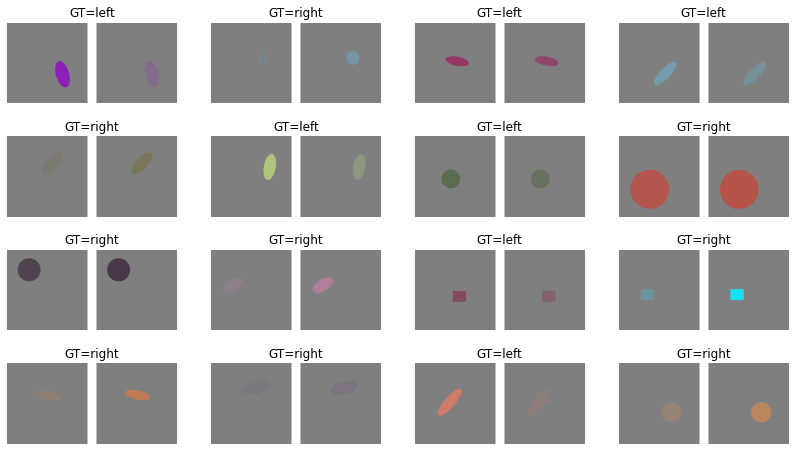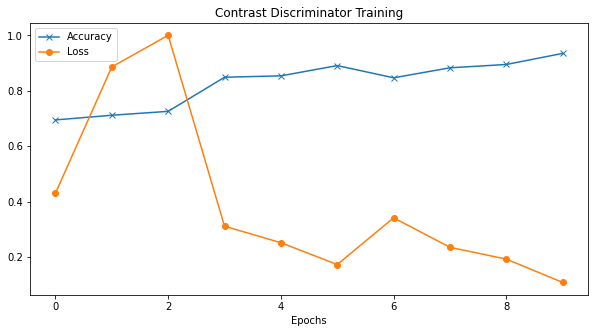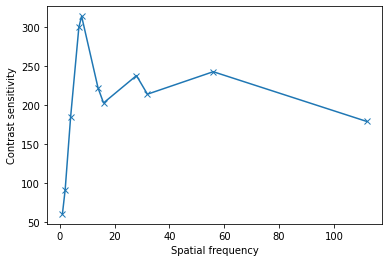7.3. Probing by linear classifiers#
This tutorial showcases how to use linear classifiers to interpret the representation encoded in different layers of a deep neural network. We study that in pretrained networks trained on ImageNet.
To assess whether a certain feature is encoded in the representation learnt by a network, we can check its discrimination power for that said feature. We cannot directly ask the pretrained network about the feature of interest, therefore we interpret the learnt representation using a linear classifier. We extract features from a frozen pretrained network, and only the weights of the linear classifier are optimised during the training.

In this technique:
We can extract features at any layer.
Often the extracted features have a large dimensionality because of the spatial resolution, one can reduce this by adaptive pooling mechanism without learning any parameters.
We must make sure, the obtained results are not due to (or biased by) the training procedure of the linear classifier.
Example articles that use this technique:
0. Packages#
Let’s start with all the necessary packages to implement this tutorial.
numpy is the main package for scientific computing with Python. It’s often imported with the
npshortcut.matplotlib is a library to plot graphs in Python.
os provides a portable way of using operating system-dependent functionality, e.g., modifying files/folders.
cv2 is a leading computer vision library.
torch is a deep learning framework that allows us to define networks, handle datasets, optimise a loss function, etc.
# importing the necessary packages/libraries
import numpy as np
from matplotlib import pyplot as plt
import random
import os
import cv2
import torch
import torchvision
from torchvision import models
import torchvision.transforms as torch_transforms
device#
Choosing CPU or GPU based on the availability of the hardware.
device = torch.device('cuda' if torch.cuda.is_available() else 'cpu')
1. Stimuli#
We study contrast discrimination. Our final goal is to measure the contrast sensitivity function (CSF) of deep networks and check whether it resembles the CSF of humans.
Train dataset#
We use our geometrical drawing dataset for training. This time the dataset returns two images that are identical in all aspects except their level of contrast. The task of network is to identify which image has a higher contrast.
labels_map = {
0: "circle",
1: "ellipse",
2: "rectangle"
}
def create_random_shape(img_size):
"""This function generates geometrical shapes on top of a background image."""
# choosing a colour for the shape, there is a slim chance of being identical to the background,
# we can consider this the noise in our dataset!
img = np.zeros((img_size, img_size, 3), dtype='uint8') + 128
colour = [random.randint(0, 255) for _ in range(3)]
point1 = np.random.randint(img.shape[0] // 4, 3 * (img.shape[0] // 4), 2)
# drawing a random geometrical shape
shape_ind = np.random.randint(0, len(labels_map))
# when the thickness is negative, the shape is drawn filled
thickness = -1
if shape_ind == 0: # circle
radius = np.random.randint(10, img.shape[0] // 4)
img = cv2.circle(img, point1, radius, color=colour, thickness=thickness)
elif shape_ind == 1: # ellipse
axes = [
np.random.randint(10, 20),
np.random.randint(30, img.shape[0] // 4)
]
angle = np.random.randint(0, 360)
img = cv2.ellipse(img, point1, axes, angle, 0, 360, color=colour, thickness=thickness)
else: # rectangle
point2 = np.random.randint(0, img.shape[0], 2)
img = cv2.rectangle(img, point1, point2, color=colour, thickness=thickness)
return img, shape_ind
def _adjust_contrast(image, amount):
return (1 - amount) / 2.0 + np.multiply(image, amount)
class ContrastDataset(torch.utils.data.Dataset):
def __init__(self, num_imgs, target_size, transform=None):
"""
Parameters:
----------
num_imgs : int
The number of samples in the dataset.
target_size : int
The spatial resolution of generated images.
transform : List, optional
The list of transformation functions,
"""
self.num_imgs = num_imgs
self.target_size = target_size
self.transform = transform
def __len__(self):
return self.num_imgs
def __getitem__(self, _idx):
# our routine doesn't need the idx, which is the sample number
img1, _ = create_random_shape(self.target_size)
# we make two images, one with high-contrast and another with low-contrast
img1 = img1.astype('float32') / 255
img2 = img1.copy()
rnd_contrasts = np.random.uniform(0.04, 1, 2)
# network's task is to find which image has a higher contrast
gt = np.argmax(rnd_contrasts)
img1 = _adjust_contrast(img1, rnd_contrasts[0])
img2 = _adjust_contrast(img2, rnd_contrasts[1])
if self.transform:
img1 = self.transform(img1)
img2 = self.transform(img2)
return img1.float(), img2.float(), gt
Torch Tensors#
Before inputting a network with our images we normalise them to the range of values that the pretrained network was trained on.
While this step is not strictly speaking mandatory, it’s sensible to measure the response of kernels under similar conditions that the network is meant to function.
In the end, we visualise the tensor images (after inverting the normalisation). This is often a good exercise to do to ensure what we show to networks is correct.
# the training size of ImageNet pretrained networks
target_size = 224
# mean and std values of ImageNet pretrained networks
mean = [0.485, 0.456, 0.406]
std = [0.229, 0.224, 0.225]
# the list of transformation functions
transform = torch_transforms.Compose([
torch_transforms.ToTensor(),
torch_transforms.Normalize(mean=mean, std=std)
])
num_imgs = 1000
train_db = ContrastDataset(num_imgs, target_size, transform)
batch_size = 32
train_loader = torch.utils.data.DataLoader(
train_db, batch_size=batch_size, shuffle=True,
num_workers=0, pin_memory=True, sampler=None
)
Visualise samples#
fig = plt.figure(figsize=(14, 8))
for i in range(16):
ax = fig.add_subplot(4, 4, i+1)
img_i1, img_i2, gt_i = train_db.__getitem__(i)
# image should be detached from gradient and converted to numpy "detach().cpu().numpy()"
# the axis should change to <width, height, channel> "transpose(1, 2, 0)"
# the normalisation should be inverted for visualisation purposes "* std + mean"
img_i1 = img_i1.detach().cpu().numpy().transpose(1, 2, 0) * std + mean
img_i2 = img_i2.detach().cpu().numpy().transpose(1, 2, 0) * std + mean
img_i = np.concatenate([img_i1, np.ones((target_size, 25, 3)), img_i2], axis=1)
ax.imshow(img_i)
ax.axis('off')
ax.set_title('GT=%s' % ('left' if gt_i == 0 else 'right'))

Test dataset#
We opted for the contrast detection task similar to the ModelFest dataset, aiming to measure the networks’ contrast sensitivity function (CSF) as closely as possible to human psychophysics. Each trial consisted of two intervals, where one interval showed an image with a non-zero contrast modulated sinusoidal gratings, and the other showed an image of the uniform grey background of \(0\%\) contrast.
During testing at each trial, we make a new instance of our GratingsDataset, each time increasing/decreasing the contrast levels passed to the initialiser depending on the performance of the network. In other words, the sinusoidal grating contrast is adjusted with a staircase procedure until the network reached \(75\%\) correct - the same threshold typically assumed in human experiments.
def sinusoid_grating(img_size, amp, omega, rho, lambda_wave):
if type(img_size) not in [list, tuple]:
img_size = (img_size, img_size)
# Generate Sinusoid grating
# sz: size of generated image (width, height)
radius = (int(img_size[0] / 2.0), int(img_size[1] / 2.0))
[x, y] = np.meshgrid(range(-radius[0], radius[0] + 1), range(-radius[1], radius[1] + 1))
stimuli = amp * np.cos((omega[0] * x + omega[1] * y) / lambda_wave + rho)
return stimuli
class GratingsDataset(torch.utils.data.Dataset):
def __init__(self, target_size, contrasts, sf, transform=None):
"""
Parameters:
----------
target_size : int
The spatial resolution of generated images.
transform : List, optional
The list of transformation functions,
"""
self.target_size = target_size
self.transform = transform
self.contrasts = contrasts
self.sf = sf
self.thetas = np.arange(0, np.pi + 1e-3, np.pi / 12)
def __len__(self):
return len(self.thetas)
def __getitem__(self, idx):
theta = self.thetas[idx]
omega = [np.cos(theta), np.sin(theta)]
lambda_wave = (self.target_size * 0.5) / (np.pi * self.sf)
# generating the gratings
sinusoid_param = {
'amp': self.contrasts[0], 'omega': omega, 'rho': 0,
'img_size': self.target_size, 'lambda_wave': lambda_wave
}
img1 = sinusoid_grating(**sinusoid_param)
sinusoid_param['amp'] = self.contrasts[1]
img2 = sinusoid_grating(**sinusoid_param)
# if the target size is even, the generated stimuli is 1 pixel larger.
if np.mod(self.target_size, 2) == 0:
img1 = img1[:-1, :-1]
img2 = img2[:-1, :-1]
# multiply by a Gaussian
radius = int(self.target_size / 2.0)
[x, y] = np.meshgrid(range(-radius, radius + 1), range(-radius, radius + 1))
sigma = self.target_size / 6
gauss_img = np.exp(-(np.power(x, 2) + np.power(y, 2)) / (2 * np.power(sigma, 2)))
if np.mod(self.target_size, 2) == 0:
gauss_img = gauss_img[:-1, :-1]
gauss_img = gauss_img / np.max(gauss_img)
img1 *= gauss_img
img2 *= gauss_img
# bringing the image in the range of 0-1
img1 = (img1 + 1) / 2
img2 = (img2 + 1) / 2
# converting it to 3 channel
img1 = np.repeat(img1[:, :, np.newaxis], 3, axis=2)
img2 = np.repeat(img2[:, :, np.newaxis], 3, axis=2)
if self.transform:
img1 = self.transform(img1)
img2 = self.transform(img2)
gt = np.argmax(self.contrasts)
return img1.float(), img2.float(), gt
contrasts = [0, 1.]
sf = 4
test_db = GratingsDataset(target_size, transform=transform, contrasts=contrasts, sf=sf)
fig = plt.figure(figsize=(14, 6))
for i in range(12):
ax = fig.add_subplot(3, 4, i+1)
img_i1, img_i2, gt_i = test_db.__getitem__(i)
# image should be detached from gradient and converted to numpy "detach().cpu().numpy()"
# the axis should change to <width, height, channel> "transpose(1, 2, 0)"
# the normalisation should be inverted for visualisation purposes "* std + mean"
img_i1 = img_i1.detach().cpu().numpy().transpose(1, 2, 0) * std + mean
img_i2 = img_i2.detach().cpu().numpy().transpose(1, 2, 0) * std + mean
img_i = np.concatenate([img_i1, np.ones((target_size, 25, 3)), img_i2], axis=1)
ax.imshow(img_i)
ax.axis('off')
ax.set_title('GT=%s' % 'left' if gt_i == 0 else 'right')
Clipping input data to the valid range for imshow with RGB data ([0..1] for floats or [0..255] for integers).
Clipping input data to the valid range for imshow with RGB data ([0..1] for floats or [0..255] for integers).
Clipping input data to the valid range for imshow with RGB data ([0..1] for floats or [0..255] for integers).
Clipping input data to the valid range for imshow with RGB data ([0..1] for floats or [0..255] for integers).
Clipping input data to the valid range for imshow with RGB data ([0..1] for floats or [0..255] for integers).
Clipping input data to the valid range for imshow with RGB data ([0..1] for floats or [0..255] for integers).
Clipping input data to the valid range for imshow with RGB data ([0..1] for floats or [0..255] for integers).
Clipping input data to the valid range for imshow with RGB data ([0..1] for floats or [0..255] for integers).
Clipping input data to the valid range for imshow with RGB data ([0..1] for floats or [0..255] for integers).
Clipping input data to the valid range for imshow with RGB data ([0..1] for floats or [0..255] for integers).
Clipping input data to the valid range for imshow with RGB data ([0..1] for floats or [0..255] for integers).
Clipping input data to the valid range for imshow with RGB data ([0..1] for floats or [0..255] for integers).

2. Network#
The structure of our network is quite similar to transfer learning we saw in an earlier class. The main difference is that:
in
LinearProbetheforwardfunction receives two images,it extracts features from the pretrained network for each image independently,
it concatenates the extract features and inputs it to the linear classifier that perform a 2AFC.
class LinearProbe(torch.nn.Module):
def __init__(self, pretrained=None):
super(LinearProbe, self).__init__()
if pretrained is None:
pretrained = models.resnet50(weights=models.ResNet50_Weights.IMAGENET1K_V1).to(device)
pretrained = torch.nn.Sequential(*list(pretrained.children())[:6])
pretrained.eval()
self.feature_extractor = pretrained
for p in self.feature_extractor.parameters():
p.requires_grad = False
feature_size = 512 * 28 * 28
self.fc = torch.nn.Linear(2 * feature_size, 2)
def forward(self, x1, x2):
x1 = self.feature_extractor(x1)
x1 = torch.flatten(x1, start_dim=1)
x2 = self.feature_extractor(x2)
x2 = torch.flatten(x2, start_dim=1)
x = torch.cat([x1, x2], dim=1)
return self.fc(x)
3. Training#
def accuracy(output, target, topk=(1,)):
"""Computes the accuracy over the k top predictions for the specified values of k"""
with torch.no_grad():
maxk = max(topk)
batch_size = target.size(0)
_, pred = output.topk(maxk, 1, True, True)
pred = pred.t()
correct = pred.eq(target.view(1, -1).expand_as(pred))
res = []
for k in topk:
correct_k = correct[:k].reshape(-1).float().sum(0, keepdim=True)
res.append(correct_k.mul_(100.0 / batch_size))
return res
def epoch_loop(model, db_loader, criterion, optimiser):
# usually the code for train/test has a large overlap.
is_train = False if optimiser is None else True
# model should be in train/eval model accordingly
model.train() if is_train else model.eval()
accuracies = []
losses = []
outputs = []
with torch.set_grad_enabled(is_train):
for batch_ind, (img1, img2, target) in enumerate(db_loader):
# moving the image and GT to device
img1 = img1.to(device)
img2 = img2.to(device)
target = target.to(device)
# calling the network
output = model(img1, img2)
outputs.extend([out for out in output])
# computing the loss function
loss = criterion(output, target)
losses.extend([loss.item() for i in range(img1.size(0))])
# computing the accuracy
acc = accuracy(output, target)[0].cpu().numpy()
accuracies.extend([acc for i in range(img1.size(0))])
if is_train:
# compute gradient and do SGD step
optimiser.zero_grad()
loss.backward()
optimiser.step()
return accuracies, losses, outputs
linear_probe = LinearProbe().to(device)
params_to_optimize = [{'params': [p for p in linear_probe.fc.parameters()]}]
momentum = 0.9
learning_rate = 0.1
weight_decay = 1e-4
optimizer = torch.optim.SGD(
params_to_optimize, lr=learning_rate,
momentum=momentum, weight_decay=weight_decay
)
# doing epoch
criterion = torch.nn.CrossEntropyLoss().to(device)
epochs = 10
initial_epoch = 0
train_logs = {'acc': [], 'loss': []}
for epoch in range(initial_epoch, epochs):
train_log = epoch_loop(linear_probe, train_loader, criterion, optimizer)
print('[%.3d] loss=%.4f acc=%0.2f' % (epoch, np.mean(train_log[1]), np.mean(train_log[0])))
train_logs['acc'].append(np.mean(train_log[0]))
train_logs['loss'].append(np.mean(train_log[1]))
[000] loss=115.6556 acc=69.50
[001] loss=237.9370 acc=71.20
[002] loss=268.4674 acc=72.60
[003] loss=83.7455 acc=84.90
[004] loss=67.7514 acc=85.40
[005] loss=46.6342 acc=89.10
[006] loss=91.8471 acc=84.70
[007] loss=63.2980 acc=88.30
[008] loss=51.8716 acc=89.50
[009] loss=29.2941 acc=93.50
Loss – accuracy#
We’re not really interested in the outcome of training, this is just a tool that allows us to do the testing (e.g., psychophysics). Nevertheless, we must ensure that the linear classifier is learning to perform the task.
Note: if the linear classifier never learns this task (after different hyper-parameter tuning), we can conclude that our feature of interest (in this example contrast) is not encoded in the representation of the network.
plt.figure(figsize=(10,5))
plt.title("Contrast Discriminator Training")
plt.plot(np.array(train_logs['acc']) / 100, '-x', label="Accuracy")
plt.plot(train_logs['loss'] / np.max(train_logs['loss']), '-o', label="Loss")
plt.xlabel("Epochs")
plt.legend()
plt.show()

4. Testing#
We test the network with a staircase paradigm. At every spatial frequency
[1, 2, 4, 7, 8, 14, 16, 28, 32, 56, 112]
We test the network with two images, one with 0% contrast and another with positive contrast. We gradually adjust the level of contrast till networks reach \(75\%\) accuracy.
def midpoint(acc, low, mid, high, th, ep=1e-4):
diff_acc = acc - th
if abs(diff_acc) < ep:
return None, None, None
elif diff_acc > 0:
new_mid = (low + mid) / 2
return low, new_mid, mid
else:
new_mid = (high + mid) / 2
return mid, new_mid, high
def _sensitivity_sf(model, sf):
"""Computing the psychometric function for given spatial frequency."""
low = 0
high = 1
mid = (low + high) / 2
res_sf = []
attempt_i = 0
# th=0.749 because test samples are 16, 12 correct equals 0.75 and test stops
th = 0.749
while True:
db_loader = torch.utils.data.DataLoader(
GratingsDataset(target_size, transform=transform, contrasts=[0, mid], sf=sf),
batch_size=13, shuffle=False, num_workers=0, pin_memory=True, sampler=None
)
val_log = epoch_loop(model, db_loader, criterion, None)
accuracy = np.mean(val_log[0]) / 100
res_sf.append(np.array([sf, accuracy, mid]))
new_low, new_mid, new_high = midpoint(accuracy, low, mid, high, th=th)
if new_mid is None or attempt_i == 20:
break
else:
low, mid, high = new_low, new_mid, new_high
attempt_i += 1
return res_sf
# spatial frequencies
sfs = [i for i in range(1, int(target_size / 2) + 1) if target_size % i == 0]
sensitivities = []
for i in range(len(sfs)):
print('spatial frequency', sfs[i])
res_i = _sensitivity_sf(linear_probe, sfs[i])
sensitivities.append(1 / res_i[-1][-1])
spatial frequency 1
spatial frequency 2
spatial frequency 4
spatial frequency 7
spatial frequency 8
spatial frequency 14
spatial frequency 16
spatial frequency 28
spatial frequency 32
spatial frequency 56
spatial frequency 112
Results#
We plot the contrast sensitivity as a function of spatial frequency. The results of our current training suggest this network is more sensitive to spatial frequency 8 cycles per image.
plt.plot(sfs, sensitivities, '-x')
plt.xlabel("Spatial frequency")
plt.ylabel("Contrast sensitivity")
plt.show()

5. Systematic experiments#
Using a linear classifier to probe the internal representation of pretrained networks:
allows for unifying the psychophysical experiments of biological and artificial systems,
is not limited to measuring the contrast sensitivity function of a network, and it can be used for other psychophysics.

